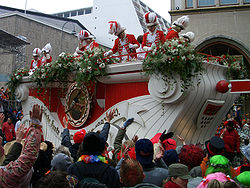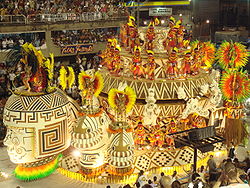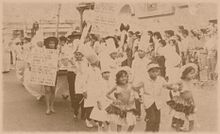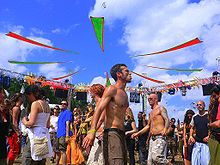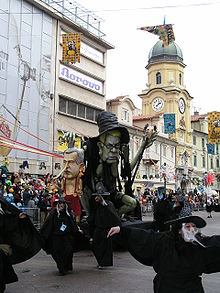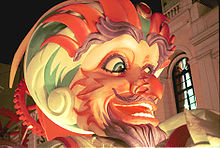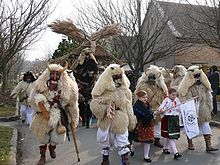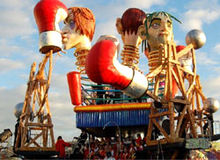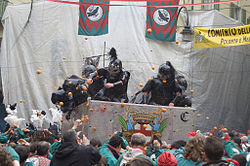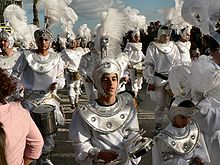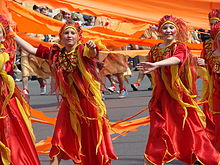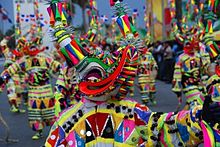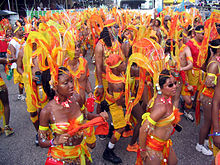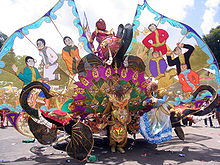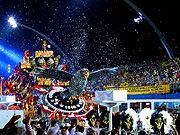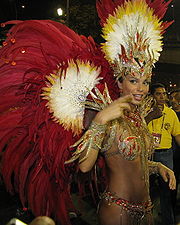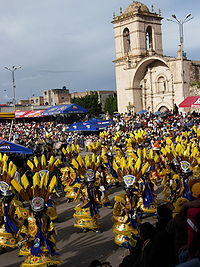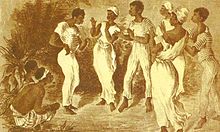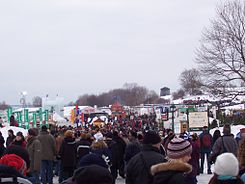- Carnival
-
Carnival is a festive season which occurs immediately before Lent; the main events are usually during February. Carnival typically involves a public celebration or parade combining some elements of a circus, mask and public street party. People often dress up or masquerade during the celebrations, which mark an overturning of daily life.
Carnival is a festival traditionally held in Roman Catholic and, to a lesser extent, Eastern Orthodox societies. Protestant areas usually do not have carnival celebrations or have modified traditions, such as the Danish Carnival or other Shrove Tuesday events. The Brazilian Carnaval is one of the best-known celebrations today, but many cities and regions worldwide celebrate with large, popular, and days-long events. The Carnival of Rio de Janeiro is the biggest carnival in the world, and the biggest popular party on the planet, according to The Guinness Book of World Records 2010. The Rio de Janeiro Carnival is also considered the world's most famous.
History
The Lenten period of the Liturgical year Church calendar, being the six weeks directly before Easter, was marked by fasting and other pious or penitential practices. Traditionally during Lent, no parties or other celebrations were held, and people refrained from eating rich foods, such as meat, dairy, fats and sugar. The forty days of Lent, recalling the Gospel accounts of the forty days that Jesus spent in the wilderness, serve to mark an annual time of turning. In the days before Lent, all rich food and drink had to be disposed of. The consumption of this, in a giant party that involved the whole community, is thought to be the origin of Carnival.
While it forms an integral part of the Christian calendar, particularly in Catholic regions, some carnival traditions may date back to pre-Christian times. The ancient Roman festivals of Saturnalia and Bacchanalia may possibly have been absorbed into the Italian Carnival. The Saturnalia, in turn, may be based on the Greek Dionysia and Oriental festivals. While medieval pageants and festivals such as Corpus Christi were church-sanctioned celebrations, carnival was also a manifestation of medieval folk culture. Many local carnival customs are based on local pre-Christian rituals, for example the elaborate rites involving masked figures in the Swabian-Alemannic carnival.
Some of the best-known traditions, including carnival parades and masquerade ball masquerading, were first recorded in medieval Italy. The carnival of Venice was for a long time the most famous carnival. From Italy, carnival traditions spread to the Catholic nations of Spain, Portugal, and France. From France, they spread to the Rhineland of Germany, and to New France in North America. From Spain and Portugal, they spread with Catholic colonization to the Caribbean and Latin America.
Other areas have developed their own traditions. In the United Kingdom, West Indian immigrants brought with them the traditions of Caribbean Carnival, however the Carnivals now celebrated at Notting Hill, London; Leeds, Yorkshire, and other places have become divorced from their cycle in the religious year, becoming purely secular events, that take place in the summer months.
Etymology
The origin of the name "carnival" is disputed, between those that have argue a link with the Italian word "carne" (meat), and those that argue a link with the word "carrus" (car). The link with carne would suggest an origin within Christianity, while the link with carro with earlier religions.
From carne levare
Those that argue for the origin from "carne," point to variants in Italian dialects that would suggest that the name comes from the Italian carne levare or similar, meaning "to remove meat", since meat is prohibited during Lent.[1]
From carne vale
Folk etymologies[1] exist which state that the word comes from the Late Latin expression carne vale, which means "farewell to meat", signifying that those were the last days when one could eat meat before the fasting of Lent. The word carne may also be translated as flesh, so suggesting carne vale as "a farewell to the flesh", a phrase actually embraced by certain carnival celebrants who encourage letting go of your former (or everyday) self and embracing the carefree nature of the festival. However, explanations proceeding from carne vale seem to be folk etymologies and are not supported by philological evidence.[1]
Other scholars argue for the origin from the Roman name for the festival of the Navigium Isidis (ship of Isis), where the image of Isis was carried to the sea-shore to blessing the start of the sailing season.[2] The festival consisted in a parade of masks following an adorned wooden boat, that would reflect the floats of modern carnivals.[3] Modern carnival shares resemblances with the Navigium Isidis.[4]
Carnival in specific countries
Asia
Indonesia
On Saturday evening June 25th 2011, the main street of Solo in Central Java turned into a massive Runway as the 4th edition of Solo Batik Carnival was staged before enthusiastic spectators. Presenting “The Amazing Legend” as its main theme, the carnival left thousands thrilled as the parade passed by showing a large variety of the most extravagant batik fashions.
Crowds cramped the sidewalks along the 3,7 Km Slamet Riyadi Street long before the parade started. Anticipation rose further an hour before the carnival was due to commence, as crowds filled not only the sidewalks but spilled over to the main street. Officers in charge and the police were kept busy clearing the street and managing the highly enthusiastic multitude.
At exactly 19.30 Western Indonesia Time, the carnival began its fantastic parade starting from the Purwosari Street. Thundering applause and roaring oohs and aahs broke from the special viewing stages and the sidewalk of the Slamet Riyadi Street as the parade passed. The colorful batik fashions and attractive choreography simply hypnotized the viewers who seemed to be absorbed into the Javanese legends presented.
Through the various colors, motives and style, the carnival highlighted four of the most renowned Javanese folk-legends: the Andhe-andhe lumut, Ratu Kencana Wungu, Ratu Laut Selatan (The tale of the Queen of the South Seas), and the romantic tale of Roro Jongrang that led to the creation of the Prambanan Temple. The event was also highlighted by the appearance of four winners of the Miss Indonesia beauty pageant : Nadine Alexandra Dewi , Inda Adeliani , Alessandra K Usman , and Reisa Kartikasari.
The event was also attended by the Mayor of Solo, Joko Widodo , and vice Mayor Hadi Rudyatmo, who both followed the parade on foot from the start to the finish-line at the Solo City Hall, wearing distinguished costumes normally worn only by the nobility.
As a tradition that has flourished for many generations, the art of Batik is inseparable from Javanese culture. Symbolizing gracefulness and precision in its creation, the intricate fabric of Batik itself is the epitome of Javanese elegance, balance and philosophy.
And as the seat of Javanese culture and tradition, the city of Solo possesses some of the best examples of Batik Keraton or Royal Batik, an artistic tradition that has been passed down since the ancient Javanese kingdoms. Its close proximity to Yogyakarta and world heritage sites such as the Borobudur and Prambanan Temples has made Solo the perfect location to celebrate the everlasting Javanese creative tradition of Batik.
India
In India, Carnival is celebrated on a grand scale in the state of Goa. In Goa, Carnival is known as 'Intruz' (from the Portuguese word Entrudo, an alternative name for Carnival), and the largest celebration takes place in the city of Panaji. The Carnival is unique to Goa in India, and was introduced by the Portuguese who ruled over Goa for over four centuries. The carnival is celebrated for three days and nights, when the legendary King Momo takes over the state and the streets come alive with music and color. Huge parades are organized throughout the state with bands, dances and floats out all night on the streets, and grand balls held in the evenings.[5]
Europe
"Karneval" redirects here. For the manga, see Karneval (manga).Belgium
Many parts of Belgium celebrate Carnival, typically with costume parades, partying and fireworks. These areas include Heist, Binche, Aalst, Eupen, Malmedy and Kelmis.
The Carnival of Binche has a history dating back at least to the 16th century. Parades are held over the three days before Lent; the most important participants are the Gilles, who go out in traditional costumes on Shrove Tuesday and throw blood oranges to the crowd.[6] In 2003, the Carnival of Binche was recognised as one of the Masterpieces of the Oral and Intangible Heritage of Humanity.[7] The Carnival at Aalst, which is celebrated for the full week preceding Ash Wednesday, is expected to receive the same recognition in 2010.[8]
Some Belgian cities hold carnivals later during Lent. One of the best-known is Stavelot, where the Carnaval de la Laetare takes place on Laetare Sunday, the fourth Sunday of Lent. The participants include the Blancs-Moussis, who dress in white with long red noses, and parade through town attacking bystanders with confetti and dried pig bladders. The town of Halle also celebrates on Laetare Sunday.
Bosnia and Herzegovina
In Bosnia and Herzegovina, the city of Ljubuški holds a traditional carnival (Bosnian: Karneval). Ljubuški is a member of the Federation of European Carnival Cities (FECC).
Croatia
The most famous Croatian carnival (Croatian: "karneval", also called "maškare") is the Rijeka Carnival, during which the mayor of Rijeka hands over the keys to the city to the Carnival master ("meštar od karnevala") and the spirit of the Carnival takes over completely. The festival includes several different events, culminating on the final Sunday in a masked procession including participants from many different countries. (A similar procession for children takes place on the previous day.)
Many other towns in Croatia's Kvarner region (and in other parts of the country) observe the Carnival period, often incorporating local traditions and celebrating local culture. Just before the end of Carnival, every Kvarner town burns a man-like doll called a "mesopust," who is blamed for all the strife of the previous year. Another famous tradition of "Karneval" are the Zvončari, or bell-ringers, who wear bells and large head regalia representing their areas of origin (for example, those from Halubje wear regalia in the shape of animal heads). The traditional Carnival food is fritule, a pastry. This festival can also be called Poklade.
Masks are central to the Carnival celebration, and worn to many of the festivities, including concerts and parties. Children and teachers are commonly allowed to wear masks to school for a day, and also wear masks at school dances or while trick-or-treating. There are also summer carnivals. One of the most famous is the Senj Summer Carnival - the first was 1968. and the tradition stayed. Many other towns in the surroundings also organise Summer Carnivals (Mali Lošinj, Pag, Novi Vinodolski, Fužine, etc.).
Cyprus
Carnival has been celebrated on the island of Cyprus for centuries, and the tradition is believed to have been established under Venetian rule around the 16th century. It may also have been influenced by Greek traditions, such as festivities for deities such as Dionysus. The celebration originally involved dressing in fancy costumes and holding masked balls or visiting friends. For approximately the past century, it has taken the form of an organized festival held during the 10 days preceding Lent (according to the Greek Orthodox calendar). The festival is celebrated almost exclusively in the city of Limassol.
Three main parades take place during Carnival. The first is held on the first day, during which the "Carnival King" (either a person in costume or an effigy) rides through the city on his carriage. The second is held on the first Sunday of the festival and the participants are mainly children. The third and largest takes place on the last day of Carnival, and involves hundreds of people walking in costume along the town's longest avenue. The latter two parades are open to anyone who wishes to participate.
Czech Republic
In the Czech Republic, the Masopust festival takes place from Epiphany (Den tří králů) through Ash Wednesday (Popeleční středa). The word masopust translates literally from old Czech to mean "meat fast", and the festival often includes a pork feast in preparation for Lent. The tradition is most common in Moravia but does occur in Bohemia as well. While practices vary from region to region, masks and costumes are present everywhere.
Denmark and Norway
Carnival in Denmark is called Fastelavn, and is held on the Sunday or Monday before Ash Wednesday. The holiday is sometimes described as a Nordic Halloween, with children dressing in costume and gathering treats for the Fastelavn feast. One popular custom is the fastelavnsris, a switch that children use to flog their parents to wake them up on Fastelavns Sunday.
In Norway, students having seen celebrations in Paris introduced carnival processions, masked balls and carnival balls to Christiana in the 1840s and 1850s. From 1863, the artist federation kunstnerforeningen held annual carnival balls in the old freemasons lodge, which inspired Johan Svendsens compositions "Norsk Kunstnerkarneval" and "Karneval in Paris". The following year, Svendsens Festpolonaise was written for the opening procession of the carnival ball. Edvard Grieg also attended the carnival, and wrote "aus dem Karneval" (folkelivsbilleder Op. 19). After the Rococo Hall at Grand Hotel opened in 1894, annual balls in the carnival season were arranged until the hall was destroyed in a fire in 1957. Since 1988, the student organization Tårnseilerne have produced annual masquerade balls in Oslo in the historical renovated freemasons lodge in the carnival tradition, with masks, costumes and processions after attending an opera performance. The carnival season also includes Fastelavens søndag (with cream buns) and fastelavensris with decorated branches.
England
The largest carnival in England is Notting Hill carnival. It is known to be one of the largest carnivals in the world, sometimes debated to be the largest in the world, but it has usually been suggested Rio de Janeiro the larger of the two. In England, the season immediately before Lent was called Shrovetide. It was a time for confessing sins (shriving) with fewer festivities than the Continental Carnivals. Today, Shrove Tuesday is celebrated as Pancake Day, but little else of the Lent-related Shrovetide survived the 16th-century English Reformation. Possibly the only Shrovetide carnival in the United Kingdom is celebrated in Cowes and East Cowes on the Isle of Wight; it is the first carnival on the island's long and busy calendar.
France
The two major carnivals of France are the Nice Carnival and the Paris Carnival. The Nice Carnival was held as far back as 1294, and is still held annually, attracting over a million visitors yearly during the two weeks preceding Lent. The Paris Carnival occurs after the Feast of Fools and dates back to the 16th century or earlier, although it was not held between 1952 and 1957.
Germany, Switzerland and Austria
Main article: Carnival in Germany, Switzerland and AustriaAlthough the festival and party season in Germany starts on 11 November at 11:11 am, the actual Carnival week begins on the Thursday before Ash Wednesday. German Carnival parades are held on the weekend before and especially on Rose Monday, and occasionally on Shrove Tuesday as well in the suburbs of larger cities. The carnival session begins each year on 11 November at 11:11 am and finishes on Ash Wednesday with the main festivities occurring around Rosenmontag; this time is also called the "Fifth Season."
In German-speaking countries, two distinct varieties of Carnivals are held. The Rheinish Carnival is held in the west of Germany, mainly in the states of North Rhine-Westphalia, Baden-Württemberg, Rhineland Palatinate, and is famous for celebrations such as parades and costume balls. Cologne Carnival is the largest and most famous. On Carnival Thursday (called "Old Women Day" or "The Women's Day"), in commemoration of an 1824 revolt by washer-women, women storm city halls, cut men's ties, and are allowed to kiss any man who passes their way.
The "Swabian-Alemannic" carnival, known as Fastnacht, takes place in Baden and Swabia (Southwestern Germany), Switzerland, Alsace and Vorarlberg (Western Austria). It traditionally represents the time of year when the reign of the cold, grim winter spirits is over and these spirits are being hunted down and expelled.
Greece
The carnival season in Greece is also known as the Apokriés (Greek: Αποκριές, "saying goodbye to meat"), or the season of the "Opening of the Triodion", so named after the liturgical book used by the church from then until the Holy Week. One of the season's high points is Tsiknopémptẽ ("Smoke Thursday"), when celebrants enjoy roast beef dinners at taverns or friends' homes; the ritual is repeated the following Sunday. The following week, the last before Lent, is called Tyrinē (Greek: Τυρινή, "cheese [week]") because eating meat is not allowed, but dairy products are. The Great Lent begins on "Clean Monday", the day after "Cheese Sunday". Throughout the carnival season, people disguise themselves as maskarádes ("masqueraders") and engage in pranks and general revelry.
Patras holds the largest annual carnival in Greece; the famous Patras Carnival is a 3-day spectacle replete with concerts, balles masqués, parading troupes, floats, a treasure hunt and many events for children. The grand parade of masked troupes and floats is held at noon on Tyrine Sunday, and culminates in the ceremonial burning of the effigy of King Carnival at the Patras harbour.
In many other regions, festivities of smaller extent are organized, focused on the reenactment of traditional carnevalic customs; for example those held in Tyrnavos (Thessaly), Kozani (West Macedonia), Rethymno (Crete) and in Xanthi (East Macedonia and Thrace). Specifically Tyrnavos holds an annual Phallus festival, a traditional "phallkloric" event[9] in which giant, gaudily painted effigies of phalluses made of papier maché are paraded, and which all women present are asked to touch, or kiss, their reward for doing so being a shot of the famous local tsipouro alcohol spirit. Also every year, to the very beginning (from 1 to 8 January), mostly in regions of the Western Macedonia, there are carnaval fiestas and festivals. The most known of them is the Kastorian Carnaval or "Ragoutsaria" (Gr. "Ραγκουτσάρια")[10] [tags: Kastoria, KAstorian Carnaval, Ragoutsaria, Ραγκουτσαρια, Καστοριά]. It is taking place from 6 to 8 of January with a mass participation of the local population and thousands of visitors under the sounds of big brass bands, pipises, Macedonian and grand casa drums. It is an ancient celebration of natures' rebirth (fiestas for Dionysus (Dionysia) and Kronos (Saturnalia)), which ends the third day in a huge dance in the medieval square Ntoltso where all the bands are playing the same time and all the people are dancing too.
Hungary
In Mohács, Hungary, the Busójárás is a celebration held at the end of the Carnival season, and involves locals dressing up in woolly costumes, with scary masks and noise-makers. They perform a burial ritual to symbolise the end of winter and spike doughnuts on weapons to symbolise the defeat of Ottomans.
Italy
Main article: Carnival in ItalyThe most famous carnivals of Italy are those held in Venice, Viareggio, Ivrea and Acireale.
The carnival in Venice was first recorded in 1268. The subversive nature of the festival is reflected in Italy's many laws over the past several centuries attempting to restrict celebrations and the wearing of masks, a central feature of the carnival. Carnival celebrations in Venice were halted for many years after the city fell under Austrian control in 1798, but were revived in the late 20th century.
The month-long carnival of Viareggio is one of the most renowned in Europe, and is characterized mainly by its parade of floats and masks caricaturizing popular figures. In 2001, the town built a new "Carnival citadel" dedicated to carnival preparations and entertainment.
The carnival of Ivrea is famous for its Battle of the Oranges fought with citruses between the people by foot and the troops of the tyrant on the carts, to remember the wars that really happened during the Middle Ages.
In the most part of the Archdiocese of Milan the Carnival lasts four more days, ending on the Saturday after Ash Wednesday, because of the Ambrosian rite.
Macedonia
The most popular carnivals in the Republic of Macedonia are held in Vevčani and Strumica.
The Vevčani Carnival (Macedonian: Вевчански Kарневал, translated Vevchanski Karneval) has been held for over 1,400 years, and takes place on 13 and 14 January (New Year's Eve and New Year's Day by the old calendar). During the carnival, the village becomes a live theatre where costumed actors improvise on the streets in roles such as the traditional "August the Stupid."[11]
The Strumica Carnival (Macedonian: Струмички Карневал, translated Strumichki Karneval) has been held since at least 1670, when the Turkish author Evlija Chelebija wrote while staying there, "I came into a town located in the foothills of a high hillock and what I saw that night was masked people running house–to–house, with laughter, scream and song." The carnival has taken place in an organized form since 1991; in 1994, Strumica became a member of FECC and in 1998 hosted the XVIII International Congress of Carnival Cities. The Strumica carnival opens on a Saturday night at a masked ball where the Prince and Princess are chosen; the main carnival night is on Tuesday, when masked participants (including groups from abroad) compete in various subjects. As of 2000, the Festival of Caricatures and Aphorisms has been held as part of Strumica's carnival celebrations.
Malta
Carnival in Malta (Maltese: il-Karnival ta' Malta) has had an important place on the Maltese cultural calendar for just under five centuries, having been introduced to the Islands by Grand Master Piero de Ponte in 1535. It is held during the week leading up to Ash Wednesday, and typically includes masked balls, fancy dress and grotesque mask competitions, lavish late-night parties, a colourful, ticker-tape parade of allegorical floats presided over by King Carnival (Maltese: ir-Re tal-Karnival), marching bands and costumed revellers.
Today the largest of the carnival celebrations takes place in and around the capital city of Valletta and Floriana; however, several more "spontaneous" carnivals take place in more remote areas. The Nadur Carnival is notable for its darker themes. In 2005, the Nadur Carnival hosted the largest-ever gathering of international Carnival organizers for the FECC's global summit.
Traditional dances include the parata, which is a lighthearted re-enactment of the 1565 victory of the Knights over the Turks, and an 18th century court dance known as il-Maltija. Food eaten at the carnival includes perlini (multi-coloured, sugar-coated almonds) and the prinjolata, which is a towering assembly of sponge cake, biscuits, almonds and citrus fruits, topped with cream and pine nuts.
Netherlands
Carnival in the Netherlands is also called "Vastenavond" or "Vastelaovend", and is most celebrated in Catholic regions, mainly the southern provinces North Brabant and Limburg. Dutch Carnival is officially celebrated on the Sunday through Tuesday preceding Ash Wednesday. Although traditions vary from town to town, some common characteristics of Dutch Carnival include a parade, a "prince" plus cortège ("Council of 11"), a farmer's wedding (boerenbruiloft), and eating herring (haring happen) on Ash Wednesday.
One variant of Dutch Carnival is known as the Rijnlandsche Carnival, which can be seen in the province of Limburg. The province's capital of Maastricht holds a street carnival featuring elaborate costumes that resemble some South American and Venetian influences. Intentionally amateurish marching bands ('Zaate Hermeniekes' or 'Drunken Marching Bands') traditionally perform on the streets. In recent years samba bands have become more popular.
The oldest-known Dutch carnival festivities date from 1385 in 's-Hertogenbosch. They are depicted in several paintings by 15th-century painter Jheronimus Bosch. During the three days of the carnival, 's-Hertogenbosch changes its name to "Oeteldonk," which means "Frog Hill." This name changing tradition is common in and around North Brabant.
Poland
The Polish Carnival Season includes Fat Thursday (Polish: Tłusty Czwartek), when pączki (doughnuts) are eaten, and Śledzik (Shrove Tuesday) or Herring Day. The Tuesday before the start of Lent is also often called Ostatki (literally "lasts"), meaning the last day to party before the Lenten season.
The traditional way to celebrate Carnival is the kulig, a horse-drawn sleigh ride through the snow-covered countryside. In modern times, Carnival is increasingly seen as an excuse for intensive partying and night-clubbing, and has become more commercialized with stores offering Carnival-season sales.
Portugal
Carnival in Portugal is celebrated throughout the country, most famously in Ovar, Madeira, Loulé, Nazaré, and Torres Vedras. The carnivals in Podence and Lazarim incorporate pagan traditions such as the careto, while the Torres Vedras celebration is probably the most typical Portuguese carnival.
Ironically, although Portugal introduced Christianity and the customs related to Catholic practice to Brazil, the country has begun to adopt some aspects of Brazilian-style Carnival celebrations, in particular those of Rio de Janeiro with sumptuous parades, samba and other Brazilian musical elements.
Carnaval is celebrated throughout Portugal, but each region puts its own unique take on the festival.
In Lazarim, a municipality of Lamego, celebrations follow the pagan tradition of the Roman Saturnalias. This rustic town celebrates Carnaval by burning colorful effigies and dressing in carefully crafted, home-made costumes. The region is celebrated for its wood craftsmanship and is most for the locals’ heavy, hand-made wooden masks worn during Carnaval. The masks of Lazarim are effigies of both men and women, but both roles are performed by men. They are distinguished by their clothes, which ridiculously characterize different attributes of both men and women.
The Lazarim Carnaval cycle encompasses two periods, the first starting on the fifth Sunday before Fat Sunday. Masked figures and people wearing large sculpted heads walk through the town. The locals also feast on a wide variety of meats, above all pork. The second cycle, held on Sundays preceding Ash Wednesday, incorporates the tradition of the Compadres and Comadres, with men and women displaying light-hearted authority over the other.
Over the course of the five weeks, men prepare large masked heads and women raise funds to pay for the mannequins that will be sacrificed in a public bonfire. This is one of the key events and is a Carnaval tradition unique to Portugal. During the bonfire, a girl reads the Compadre's will and a boy reads the Comadre’s will. The executors of the will are named, a donkey is symbolically distributed to both female and male “heirs,” and then the final reckoning in which the Entrudo, or Carnaval doll, is burned.
In Estarreja in the Central region of Portugal, the town’s first references to Carnaval are noted in the 14th Century, with “Flower Battles,” or richly decorated floats which paraded through Estarreja’s streets. In the beginning of the twentieth century these festivities ended with the death of its main promoters only to reappear again in the sixties to become one of the many important Carnaval festivals in Portugal.
In the Northern region of Podence children appear from Sunday to Tuesday with tin masks and colorful multilayered costumes made from red, green and yellow wool. And in the Central Portugal towns of Nelas and Canas de Senhorim, Carnaval is one of the most important tourist events in the region, attracting thousands of visitors yearly. Nelas and Canas de Senhorim are host to the four festive parades that promise visitors colorful and creative costumes: The Bairro da Igreja and the Cimo do Povo in Nelas and the do Paço and the do Rossio in Canas de Senhorim.
One of the most famous Carnaval events in Portugal is in the town Ovar near Porto. Organized in 1952 it is the largest festivity of the region drawing thousands of visitors. It is well known for its creative designs, which they display in the Carnaval Parade. Participants and their families work year-round to prepare their elaborate and humorous costumes, masks, decorations and floats. Its Carnaval parade features troupes with themed costumes and music, ranging from the traditional to modern pop culture.
In Lisbon, Portugal’s largest city, Carnaval is a more cosmopolitan affair. Parades, dances and festivities throughout the week feature famous stars from Portugal and Brazil. The Loures Carnaval is a highlight of Lisbon’s festivities which celebrates the country’s folk traditions, including the “enterro do bacalhau” or burial of the cod, which symbolizes the end of Carnaval and the festivities.
North of Lisbon is the famous Torres Vedras Carnaval, described as the “most Portuguese in Portugal.” Those looking for a less touristy Carnaval experience should visit this town where the locals are the stars. The celebration highlight is a parade of creatively decorated streetcars satirizing society and politics.
Other Central Portugal towns, such as Fatima and Leiria, offer colorful, family-friendly takes on Carnaval. In these towns everyone dresses up as if it were Halloween. Children and adults wear masks and enjoy the towns’ enthusiastic parades.
In the Algarve region along the southern coast of Portugal, several of the posh resorts towns offer their own traditional takes on the Carnaval parades. Besides the themed floats and cars, the Carnaval festivities include “samba” groups, bands, dances and plenty of music and liveliness. In the city of Loulé, the Carnaval parade annually attracts thousands of national and foreign tourists to the region.
Azores
The Islands of the Azores have their own take on the Carnaval festivities, but like on the mainland, many local clubs and Carnaval groups create colorful and creative costumes that take a jab at the political or cultural characters of the times.
On São Miguel Island, Carnaval has a sweet taste with street vendors selling fried dough, called a Malassada. The festival on the Azores biggest island starts off with a black tie grand ball, then and heats up with Latin music at the recently restored Coliseu Micaelense. There is a children’s parade in the streets of Ponta Delgada with children from each school district coming in costume. Then a massive Carnaval parade fills the streets into the wee hours ending in fireworks.
Some of the islands’ more unique aspects to Carnaval are the theatre performances and dances. In the "Danças de Entrudo" hundreds of people follow the dancers around the island. Throughout the show the dancers, who are guided by a “master,” act out dramas from everyday life. The “Dances de Carnaval” are allegorical and comedic tales acted out in the streets throughout the festival. The largest is in “Angra do Heroísmo,” with more than 30 Carnaval groups performing. During this festival, it is said there are more Portuguese-language theatrical performances occurring here than anywhere else in the world.
The Carnaval festivities end on Ash Wednesday, when locals sit down for the "Batatada" or potato feast, in which the main dish is salted cod with potatoes, eggs, mint, bread and wine. After, residents head into the streets for the burning of the “Carnaval clown,” signaling the end of the Carnaval.
Madeira
Main article: Carnival of MadeiraOn the Island of Madeira, Carnaval maintains its distinctive local roots as well. Funchal, the island’s capital, wakes up on the Friday morning before Ash Wednesday to the sound of brass bands and Carnaval parades throughout the downtown area. That night festivities continue with concerts and shows in the Praça do Município for five consecutive days. The Main Carnaval street parade takes place on Saturday evening with thousands of Samba dancers flooding the streets of Funchal. The traditional public street Carnaval takes place on Tuesday, where the island's population displays its ingenuity and imagination by creating daring caricatures for the parade.
Russia
Maslenitsa (Russian: Масленица, also called Pancake Week or "Cheese Week") is a Russian folk holiday that incorporates some traditions that date back to pagan times. It is celebrated during the last week before Lent. The essential element of Maslenitsa celebration is bliny, Russian pancakes, popularly taken to symbolize the sun. Round and golden, they are made from the rich foods still allowed during that week by the Orthodox traditions: butter, eggs, and milk (in the tradition of Orthodox lent, the consumption of meat ceases one week before the consumption of milk and eggs).
Maslenitsa also includes masquerades, snowball fights, sledding, swinging on swings and sleigh rides. The mascot of the celebration is usually a brightly dressed straw effigy of Lady Maslenitsa, formerly known as Kostroma. As the culmination of the celebration, on Sunday evening, Lady Maslenitsa is stripped of her finery, and put to the flames of a bonfire.
In Saint Petersburg the modern celebration of the festival is organized by the city to fall on a fixed date annually (at Sunday, closest to 27 May).
Slovakia
In Slovakia, the Fašiangy (fašiang, fašangy) takes place from Three Kings Day (Traja králi) until the midnight before Ash Wednesday (Škaredá streda or Popolcová streda). At the midnight marking the end of fašiangy, a symbolic burial ceremony for the contrabass is performed, because music has to cease for the Lent.
Slovenia
Slovenia has a rich and diverse annual cycle of holidays. Much ethnic heritage has been preserved through widely attended tourist events.
The Slovenian countryside displays a variety of disguised groups and individual characters among which the most popular and characteristic is the Kurent (plural: Kurenti), a monstrous and demon-like, but fluffy figure. The most significant ethonological Carnival festival is traditionally held in annually in the town of Ptuj (see: Kurentovanje). The special feature of the event of Ptuj itself and its surrounding area are the Kurents themselves, magical creatures from the other world, who visit all major events throughout the country, members of parliament, the president and mayors, trying to banish the winter and announce the arrival of the spring, fertility, and new life with loud noise and dancing. The origin of the Kurent is a mystery, and not much is known of the times, beliefs, or purposes connected with its first appearance. The origin of the name itself is obscure.
Another town, equal in importance to Ptuj, where the carnival tradition is alive is Cerknica. The carnival is heralded by a figure called "Poganjič" carrying a whip. In the carnival procession, organised by the "Pust society", a monstrous witch named Uršula is driven from Mt. Slivnica, to be burned at the stake on Ash Wednesday. Unique to this region is a group of dormice, driven by the Devil, and a huge fire-breathing dragon. Cerkno and its surrounding area is known for the Laufarji, carnival figures with artistically carved wooden masks.
The Mačkare from Dobrepolje used to represent a triple character: the beautiful, the ugly (among which the most important represented by an old man, an old woman, a hunchback, and a Korant), and the noble (imitating the urban elite).
The major part of the population, especially the young and children, dress up in ordinary non-ethnic costumes, going to school, work, and organized events, where prizes are given for the best and most original costumes. Costumed children sometimes go from house to house asking for treats in an imitation of American Halloween.
Spain
Arguably the most famous locales in Spain are Santa Cruz de Tenerife, Las Palmas De Gran Canaria, Sitges, Vilanova i la Geltrú, Tarragona, Solsona, Cádiz, Badajoz, Bielsa (an ancestral carnival celebration), Plan, San Juan de Plan, Laza, Verín, Viana and Xinzo de Limia.
Andalusia

In Cádiz the costumes worn are often related to recent news, such as the bird flu epidemic in 2006, during which many people were disguised as chickens. The feeling of this carnival is the sharp criticism, the funny play on words and the imagination in the costumes, more than the glamorous dressings. It is traditional to paint the face with lipstick as a humble substitute of a mask.
The most famous groups are the chirigotas, choirs and comparsas. The chirigotas are well known witty, satiric popular groups who sing about politics, new times and household topics, wearing the same costume, which they train for the whole year. The Choirs (coros) are wider groups that go on open carts through the streets singing with a little orchestra of guitars and lutes. Their characteristic composition is the "Carnival Tango", and they alternate comical and serious repertory. The comparsas are the serious counterpart of the chirigota in Cádiz, and the poetical lyrics and the criticism are their main ingredients. They have a more elaborated polyphony, being easily recognizable by the typical countertenor voice.
Canary Islands
Main article: Carnival of Santa Cruz de TenerifeThe Santa Cruz de Tenerife and Las Palmas de Gran Canaria is together with the Carnival of Cadiz, the most important festival for Spanish tourism and Spain's largest carnival.[12][13][14][15] In 1980 it was declared a Festival Tourist International Interest, by the Secretariat of State for the Tourism. Every February, Santa Cruz de Tenerife, the capital of the largest of the Canary Islands, hosts the event, attracting around a million people. The celebrations could be declared by UNESCO as Heritage of Mankind in 2011. Carnival of Santa Cruz de Tenerife now aspires to become a World Heritage Site.[16]
In 1980 it was declared a Festival Tourist International Interest, by the Secretariat of State for the Tourism and it is one of the most important carnivals of the World. The Carnival of Santa Cruz de Tenerife now aspires to become a World Heritage Site.[16] This declaration by UNESCO will, occur, further promoting international had Santa Cruz de Tenerife, being the first Carnival of Spain to obtain this recognition, for its permanent in time and it would reach the five continents through UNESCO. In 1987 went to the "Carnival Chicharrero" Cuban singer Celia Cruz with orchestra Billo's Caracas Boys, attended by 250,000 people, was registered in the Guinness of Records as the largest gathering of people in an outdoor plaza to attend a concert, a record she holds today.
Main article: Carnival of Las PalmasThe Carnival of Las Palmas de Gran Canaria (Gran Canaria) has a Drag Queen's gala where a jury chooses a winner.
Catalonia
In Catalonia people dress up and organise parties for a week but particularly on the weekend. Despite it being winter, parties are open air, beginning with a cercavila to call everybody to come. Rues of people dance along the streets. On Thursday Dijous Gras is celebrated, also called 'the omelette day' (el dia de la truita), coques (de llardons, butifarra d'ou, butifarra) and omelettes are eaten. Parties end by burning Mr. Carnestoltes and with enterrament de la sardina (sardine's funeral).
Carnaval de Solsona takes place in Solsona, Lleida in central Catalonia. It is one of the longest carnivals in Catalonia; free events in the streets, and concerts every night, run for more than a week. The carnival is known for a legend that explains some people hung a donkey at the tower bell, because the animal wanted to eat some grass which grew on the top of the tower. To remember this legend, every year people in Solsona hang a stuffed donkey at the tower that "pisses" above the excited people using a water pump. This event is the most important of Solsona's Carnival and takes place on Saturday night. For this reason, the inhabitants of Solsona are called "matarrucs" ("donkey killers"). Photo:[17]
Another characteristic of the carnival is its giants. Crazy Giants will pursue and try to hit revellers with their articulated arms and legs. The Crazy Giants were created in 1978 by the giant-making master Manel Casserras i Boix. Photo:[18]
"Comparses" groups organize free activities in the streets. They are groups of friends who create and personalize a uniformed suit which is worn every year during the festivities. Website: http://www.carnavalsolsona.com/
Sitges: This carnival is one of the most famous carnivals in Catalonia. Special food includes xatonades (a xató is a traditional local salad of Sitges) served with omelettes. Two important moments are the Rua de la Disbauxa (Debauchery Parade) on Sunday night and the Rua de l'Extermini (Extermination Parade) on Tuesday night. Around 40 floats with more than 2,500 participants parade in Sitges.
The carnival of Vilanova i la Geltrú is notable for Les Comparses (on Sunday), in which good-humoured rival groups throw boiled sweets (candies) at each other. Vinanova's and Sitge's carnival are rivals.
Tarragona has one of the most complete ritual sequences of the Catalan carnivals. The events start with the building of a huge barrel and end with its burning together with the effigies of the carnival King and Queen. On Saturday, the main parade takes place. There are masked groups, zoomorphic figures, music and percussion bands, and groups with fireworks (the devils, the dragon, the ox, the female dragon). Carnival groups stand out for their clothes full of elegance, showing brilliant examples of fabric crafts, at the Saturday and Sunday parades. About 5,000 people are members of the parade groups.
North America
Caribbean
Most of the islands in the Caribbean celebrate Carnival. The largest and most well-known celebration is held in Trinidad and Tobago. The Dominican Republic, Antigua, Aruba, Cayman Islands, Curaçao, Barbados, Haiti, Dominica, Grenada, Jamaica, Saint Maarten, Saint Lucia, Saint Kitts, Saint Thomas, U.S. Virgin Islands, Saint Vincent and the Grenadines are also known for lengthy carnival seasons and large celebrations.
Carnival is an important cultural event on the Dutch Antilles islands of Aruba, Curaçao, Sint Maarten, Saba, Sint Eustatius (Statia), and Bonaire. Festivities include "jump-up" parades with beautifully colored costumes, floats, and live bands as well as beauty contests and other competitions. Carnival on these islands also includes a middle-of-the-night j'ouvert (juvé) parade that ends at sunrise with the burning of a straw King Momo, cleansing the island of sins and bad luck. On Statia he is called Prince Stupid.
Carnival has also been celebrated in Cuba since the 18th century. The costumes, dances and pageantry grew with each passing year, with the participants donning costumes from the cultural and ethnic variety on the island. After Fidel Castro's Communist Revolution, carnival's religious overture was suppressed. The events remained, albeit frowned upon by the state. Carnival celebrations have been in decline throughout Cuba since 1960.
Aruba
Carnival means weeks of events that bring you colourfully decorated floats, contagiously throbbing music, luxuriously costumed groups of celebrants of all ages, King & Queen elections, electrifying jump ups and torch light parades that wind their way through the streets at night, the Jouvert morning: the Children's Parades and finally the Grand Parade. Aruba’s biggest celebration of the year is a month-long celebration consisting of festive “jump-ups” (street parades), spectacular parades and creative contests. Music and flamboyant costumes play a central role, from the Queen elections to the Grand Parade, which winds it ways down city avenues to the delight of thousands of spectators. Street parades are held in various districts throughout the month, allowing everyone an opportunity to participate and dance to the season’s most popular brass band, steel band and roadmarch tunes. On the evening before the start of Lent, Carnival officially comes to end with the symbolic burning of “King Momo.”
Antigua
The Antiguan Carnival is a celebration of music and dance held annually from the end of July to the first Tuesday in August. The most important day is that of the j'ouvert (or juvé), in which brass and steel bands perform for much of the island's population. Barbuda's Carnival, held in June, is known as Caribana. The Antiguan and Barbudan Carnivals replaced the Old Time Christmas Festival in 1957, with hopes of inspiring tourism in Antigua and Barbuda. Some elements of the Christmas Festival remain in the modern Carnival celebrations, which are otherwise largely based on the Trinidadian Carnival. The carnival consists of mass playing, steel pan music and various shows such as calypso shows and pageants.
Barbados
Carnival in Barbados is known as Crop Over. Crop Over is Barbados' biggest festival, having had its early beginnings on the sugar cane plantations during the colonial period. The crop over tradition began in 1688, and featured singing, dancing and accompaniment by bottles filled with water, shak-shak, banjo, triangle, fiddle, guitar, and bones. Other traditions included climbing a greased pole, feasting and drinking competitions. Originally a celebration signaling the end of the yearly sugar cane harvest, it has since evolved into a national festival rivaling New Orleans Mardi Gras and Trinidad Carnival in Trinidad. In the late 20th Century, the general schematic of Crop Over began to closely mirror the Trinidad Carnival. Beginning in June, Crop Over it runs until the first Monday in August when it culminates in the finale, The Grand Kadooment.
For the entire two months life for many islanders is one big party with a major feature of crop over being the calypso competition. Calypso music, originating in Trinidad, uses syncopated rhythm and topical lyrics and gives its exponents a medium in which to satirise local politics and comment on the issues of the day, while taking nothing away from the general bacchanal. Calypso tents, also originating in Trinidad, feature their cadre of calypsonians who perform biting social commentaries on the happenings of the past year, political exposés or rousing exhortations to wuk dah waistline and roll dat bumper. There are craft markets, food tents and stalls, street parties and cavalcades every week supplemented by daily events at Tim’s on the Highway, the new home of the Barbados Cropover Festival.
Competition "tents" ring with the fierce battle of calypsonians for the coveted Calypso Monarch Award and the air is redolent with the exotic smells of Bajan cooking during the Bridgetown Market Street Fair. Rich with the spirit of local culture, the Cohobblopot Festival blends dance and drama and music with the crowning of the King and Queen of costume bands. Every evening the "Pic-o-de-Crop" Show is performed when finally the King of Calypso is crowned. The climax of the festival is Kadooment Day celebrated with a national holiday when costume bands fill the streets with pulsating Barbadian rhythms and fireworks that ignite the sky.
Dominican Republic
Main Article: Dominican Carnival
Dominican Carnival is celebrated in most cities and towns in the Dominican Republic.
It is celebrated in the main streets of each town during the month of February. One of the main characteristics of this carnival are its flashy costumes and the loud music played during the celebration. Some of the most known parades of this country are the one held in La Vega, which is one of the biggest in the country, and the National Parade held in Santo Domingo. It was here where the first carnival of the Americas was held, and it is also one of the biggest in the region.
One of the main attractions are its masks, which are very elaborate and colorful. The elaborate costumes used on the parades are satires of the Devil and are called "Diablos Cojuelos" all around the country, they dance, and run to the rhythm of Merengue mixed with techno, hip-hop, and reggeaton during the celebration. Adding to this characters the celebration also show some allegorical characters representing Dominican traditions such as "Roba la Gallina",and "Califé".
One of the most international parades in the Dominican Republic is the one in San Pedro de Macoris that exhibits the "Guloyas", which are considered cultural heritage of the world. This parade consists of groups of people dressed in costumes dancing around the street of San Pedro de Macoris. The main attraction apart from the colorful costumes is the people running away from the "Diablos Cojuelos" which try to hit people with "Vejigas".
Haiti
Haiti Kanaval has up to 1,000,000 people jamming the streets of downtown Port-au-Prince's Champs de Marse rock to Meringues (Haitian carnival melodies) on the Beton (the street course where the floats pass through).
The many different genres of Haitian Music are fully represented with the different bands that blaze through the beton New styles with foreign influence emerge continuously mixing Haitian sounds with techno, hip-hop, reggae, zouk, Fand soukous to name a few. The 20 bands in the seven-hour parade play as the chars creep through the wild crowds until 4 am. The dancers before and after the floats, dance the ga gun, an aggressive dance that can be as competitive as it is celebrative. Everybody knows the songs; every line, every chant has the audience ecstatic, with the floats themselves bouncing in time to the music. Condoms, thrown from floats and from the stands, were blown up like balloons. And long lines of people dance elaborate dances, turning the sensuality of the music into movement.
Combined, the depth of the music and dance suggests Haiti's enormous cultural power as a reservoir of African and Creole culture, underscoring its importance as one of the major producers of art in the Caribbean. And in its intensity, its Carnival is clearly one of the more important events in the African diaspora in the Americas.
Trinidad and Tobago
In Trinidad & Tobago, Carnival is a holiday season that lasts over a month and culminates in large celebrations in Port of Spain which is the capital of Trinidad, on the Sunday, Monday, and Tuesday before Ash Wednesday with Dimanche Gras, J'ouvert, and Mas (masquerade). Tobago's celebrations also culminates on Monday and Tuesday but on a much smaller scale in its capital Scarborough. Carnival is a festive time of costumes, dance, music, competitions, rum, and partying (also referred to as fete-ing). Music styles associated with Carnival include soca, calypso
The annual Carnival steel pan competition known as the National Panorama competition is held in the weeks preceding Carnival with the finals held on the Saturday before the main event. Pan players compete in various categories such as "Conventional Steel band" or "Single Pan" by performing renditions of the current year's calypsos. Preliminary judging of this event for "Conventional Steel Bands" has been recently moved to the individual pan yards where steel bands practice their selections for the competition.
"Dimanche Gras" takes place on the Sunday night before Ash Wednesday. Here the Calypso Monarch is chosen (after competition) and prize money and a vehicle bestowed. Also the King and Queen of the bands are crowned, where each band to parade costumes for the next two days submits a king and queen, from which an overall winner is chosen. These usually involve huge, complex, beautiful costumes.
J'ouvert, or "Dirty Mas", takes place before dawn on the Monday (known as Carnival Monday) before Ash Wednesday. It means ""opening of the day" . Here revelers dress in old clothes and cover themselves in mud, oil paint and body paint. A common character to be seen at this time is "Jab-jabs" (devils, blue, black or red) complete with pitch fork, pointed horns and tails. Here also, a king and queen of the J'ouvert are chosen, based on their representation of current political/social events/issues.
Carnival Monday involves the parade of the mas bands, but on a casual or relaxed scale. Usually revelers wear only parts of their costumes, and the purpose of the day is more one of fun than display or competition. Also on Carnival Monday, Monday Night Mas is popular in most towns and especially the capital, where smaller bands participate in competition.
Carnival Tuesday is when the main events of the carnival take place. On this day full costume is worn complete with make up and body paints/adornments. Each band has their costume presentation based on a particular theme, and contain various sections (some consisting of thousands of revelers) which reflect these themes. Here the street parade and eventual crowning of the best bands take place. After following a route where various judging points are located, the mas bands eventually converge on the Queen's Park Savannah to pass "on the stage" to be judged once and for all. Also taking place on this day is the crowning of the Road March king or queen, where the singer of the most played song over the two days of the carnival is crowned winner, complete with prize money and usually a vehicle.
This parading and revelry goes on into the night of the Tuesday. Ash Wednesday itself, whilst not an official holiday, is marked by most by visiting the beaches that abound both Trinidad and Tobago. The most populated being Maracas beach and Manzanilla beach, where huge beach parties take place every Ash Wednesday. These provide a cool down from the previous five days of hectic partying, parades and competitions, and are usually attended by the whole family.
Guatemala
The smallest Carnival celebration in Guatemala is in Mazatenango. During the month of February, Mazatenango is famous for its eight day Carnival Feast. Locals and visitors alike look forward to the days of food, music, parades, games, etc. that bring the streets of the capital city of the department of Suchitepéquez to life. As one Guatemalan website states, “To mention the carnival of Mazatenango is to bring to mind moments of a happy and cordial party. In the eight days of this celebration's duration the local residents have kept alive the traditions of the Department.”
Honduras
In La Ceiba in Honduras, Carnival is held on the fourth Saturday of every May to commemorate San Isidro. It is the largest Carnival celebration in Central America.
Nicaragua
In the Caribbean coast of Nicaragua, in the city of Bluefields, the carnival, better known as Palo de Mayo (or Mayo Ya!), is celebrated every day of May.
In the Nicaragua's capital city, Managua, it is only celebrated for 2 days. The carnival in Managua is named "Alegria por la vida" translated to "Joy for Life" and features a different theme each year.
There's also a Festival In Managua which is called " Santo Domingo de Guzman" which lasts ten days.
Mexico
In Mexico, Carnaval is celebrated in many cities and towns, most notably in Mazatlán, Sinaloa, Mérida, Yucatán, and in the city of Veracruz, where Carnaval is celebrated with traditional music, folklore, arts and dances. People dress in bright, feathered costumes resembling the indigenous traditions, and create a series of performances on the streets as well as on stages. In most cases there is a large set-up of fair games and roller coasters. Both Mazatlán's and Veracruz's celebrations are often compared to the carnival of Rio de Janeiro or New Orleans. In Copándaro de Galeana, Michoacán c Carnaval is celebrated with lively parades often surrounding bull riding, cockfights and dancing.
In some of the central to northern regions the popular Norteña and Mexican rodeo influences are very present, whereas in the coastal or southern regions, carnivals represent a more indigenous rendition. Each one will include many region-specific food dishes and drinks.
Panama
The Panamanian Carnival is the second biggest festival in the world[citation needed] . Traditionally beginning on Friday and ending on the Tuesday before Ash Wednesday, "los carnavales", as Panamanians refer to the days of carnival, are celebrated in almost the whole country. Carnival Week in Panama is specially popular because of the luxury and magnitude of the Las Tablas Carnival as well as the carnival celebrations in Panama City and almost all of the Azuero Peninsula. The Panamanian Carnival is also popular because of the great number of concerts by national and international artists held on different stages in the most visited areas of the country.
Canada
Caribana, held in Toronto on the first weekend of August, has its origins in the carnival traditions of the Caribbean. Due to climatic imperatives, Caribana is held in the summer when Caribbean costumes may be paraded comfortably, rather than adhering to the traditional winter dates of the other carnivals in which the festival is strongly rooted.[19] Attendance at the Caribana parade typically exceeds one million people.
The Quebec Winter Carnival is the biggest winter-themed carnival in the world.[citation needed] It depends on good snowfalls and very cold weather, to keep snowy ski trails in good condition and the many ice sculptures intact. For this reason it does not coincide with the pre-Lent celebration but is fixed instead to the last days of January and first days of February.
In the Ottawa-Gatineau region, Winterlude takes place during the first 4 weeks of February.
United States
Carnival celebrations, usually referred to as Mardi Gras, were first celebrated in the Gulf Coast area of the United States, but now occur in many other states. Customs originated in the onetime French colonial capitals of Mobile (now in Alabama), New Orleans (Louisiana) and Biloxi (Mississippi), all of which have been celebrated for many years with street parades and masked balls. Other major U.S. cities with celebrations include Miami, Florida, Tampa, Florida, St. Louis, Missouri, Pensacola, Florida, San Diego, California, Galveston, Texas and Orlando, Florida.
Carnival is celebrated in New York City in the Borough of Brooklyn. As in the UK, the timing of carnival has been separated from the Christian calendar and is celebrated on Labor Day Monday, in September. It is called the West Indian Day Parade or West Indian Day Carnival, and was founded by immigrants from Trinidad, one of the West Indian islands that has one of the largest Carnivals of the Caribbean region. In the mid twentieth century, West Indians moved the timing of the New York area Carnival from the beginning of Lent to the Labor Day weekend. The West Indian Day Carnival is one of the largest parades and street festivals in New York with usually over one million people participating or attending. The parade, which consists of steel bands, floats, elaborate carnival costumes and sound trucks proceeds down Brooklyn's Eastern Parkway in the Crown Heights neighborhood.
Louisiana
The best-known, most elaborate, and most popular events are in New Orleans, while other South Louisiana cities such as Lafayette, Mamou, Houma,and Thibodaux all of which were under French control at one time or another, are the sites of famous Carnival celebrations of their own.
Major Mardi Gras celebrations are spreading to other parts of the United States, such as the Mississippi Valley region of St. Louis, Missouri, Orlando, Florida in Universal Studios, and in the Gaslamp Quarter of San Diego, California.
South America
Argentina
In Argentina, the most representative carnival performed is the so called Murga, although other famous carnival, more Brazilian stylized, are held in the Argentine Mesopotamia and the North-East. Gualeguaychú in the east of Entre Ríos province is the most important carnival city and has one of the largest parades, with a similar afro-American musical background to Brazilian or Uruguayan Carnival. Corrientes is another city with a lively carnival tradition. Chamame, a kind of polka is played during the carnivals. In all major cities and many towns throughout the country, Carnival is also celebrated, but less famous than in the above mentioned places.
As carnival coincides with summer, in many parts of Argentina children play with water. The 19th century tradition of filling empty egg shells with water has evolved into water games that include the throwing of water balloons.
Bolivia
 The Diablada, dance primeval, typical and main of Carnival of Oruro a Masterpiece of the Oral and Intangible Heritage of Humanity since 2001 in Bolivia (Image: Fraternidad Artística y Cultural "La Diablada".
The Diablada, dance primeval, typical and main of Carnival of Oruro a Masterpiece of the Oral and Intangible Heritage of Humanity since 2001 in Bolivia (Image: Fraternidad Artística y Cultural "La Diablada".
La Diablada carnival, takes place in the city of Oruro in central Bolivia. It is celebrated in honor of the patron saint of the miners, Vírgen de Socavon (the Virgin of the Tunnels). Over 50 parade groups dance, sing and play music over a five kilometre-long course. Participants dress up as demons, devils, angels, Incas and Spanish conquerors. There are various kinds of dances such as caporales and tinkus. The parade runs from morning until late at night, 18 hours a day, 3 days before Ash Wednesday. Meanwhile throughout the country celebrations are held involving traditional rhythms and water parties. In Santa Cruz de la Sierra, at the east side of the country, the tropical weather allows a Brazilian-type carnival, with agropuations of people called "Comparsas" dancing traditional songs in matching uniforms. Declared the 2001 "Masterpieces of Oral Heritage and Intangible Heritage of Humanity" for UNESCO
Brazil
The Carnival in Brazil is a big part of the Brazilian Culture, and it is sometimes referred to by the Brazilians as the "Greatest Show on Earth".
Salvador has large Carnival celebrations, including the Axé, typical Bahia music. A truck with giant speakers and a platform where musicians play songs of local genres such as Axé music, Samba-reggae and Arrocha, is driven with the following crowd both dancing and singing. It was originally staged by two Salvador musicians, Dodo & Osmar, in the 1950s. Several cities in the state of Bahia still celebrate Carnaval this way, with as most popular the carnival of Porto Seguro.
Another important part of the Brazilian Carnival takes place in the Rio Carnival, with samba schools parading in the Sambadrome ("sambódromo" in Portuguese). It's the largest carnival event in this country, considered to be the largest of the kind in the world. Called "One of the biggest shows of the Earth", the festival attracts millions of tourists, both Brazilians and foreigners who come from everywhere to participate and enjoy the great show. Samba Schools are large, social entities with thousands of members and a theme for their song and parade each year. Tourists are allowed to participate, paying ($500–750) to buy a Samba costume and dance in the parade through the Sambadrome with one of the schools. The price paid is used to buy the tourist's own costume and also the costumes of the people who do not have the money to afford it. Blocos are generally small informal groups also with a definite theme in their samba, usually satirical of the current political situation. But there are also a lot, about 30 of them in Rio de Janeiro, that are very big in number of participants, gathering hundreds of thousands of people. There are more than 400 blocos in Rio de Janeiro. Bandas are samba musical bands, usually formed by enthusiasts in the same neighborhood.
In 2011, the carnival of Brazil, which is held 46 days before Easter, started on Friday with feasts and fanfare and samba parades on the streets of São Paulo and Rio de Janeiro. The most famous holiday event in Brazil, which occurs around Brazil and most of South America, known as Carnaval, is happening from March 4 to 8 this year. In Picture: Revellers parade for Rosas de Ouro samba school during Carnival in São Paulo March 5, 2011.[20]
Colombia
Although Carnival was introduced by the Spaniards and has incorporated elements from the European cultures, it has managed to re-interpret traditions that belonged to the African and Amerindian cultures of Colombia. There is documentary evidence that Carnival existed in Colombia in the 18th century and had already been a cause for concern for the colonial authorities, who censored the celebrations, especially in the main political centres such as Cartagena, Bogotá and Popayán.
The Carnival, therefore, continued its evolution and re-interpretation in the small and at that time unimportant towns where celebrations did not offend the ruling elites. The result was the uninterrupted celebration of Carnival festivals in Barranquilla (see Barranquilla's Carnival) which has been recognized as one of the Masterpieces of the Oral and Intangible Heritage of Humanity. The Barranquilla Carnival attracts tens of thousands of people from Colombia and around the world, having become several parades done on Friday and Saturday nights beginning on 11 January and ending always with the four-day non-stop festival, which has now been made six days long, beginning on Wednesday, exactly one week prior to Ash Wednesday and ending on Tuesday at 12pm to initiate the next day with the season of Lent. In other villages along the lower Magdalena River in northern Colombia, and in Pasto, Nariño (see Blacks and Whites Carnival) in the south of the country. In modern times, there have been attempts to introduce Carnival in the capital, Bogotá, in the early 20th century, but it has always failed to gain the approval of authorities. The Bogotá Carnival has had to wait until the 21st century to be resurrected, this time by the authorities of the city.
Ecuador
In Ecuador, the celebrations have a history that begins before the arrival of Catholicism. It is known that the Huarangas Indians (from the Chimbos nation) used to celebrate the second moon of the year with a festival at which they threw flour, flowers and perfumed water. This once pagan tradition has since merged with the Catholic celebration of Carnaval.
A common feature of Ecuadorian Carnival is the diablitos (little devils) who play with water. As with snowball fights, the practice of throwing or dumping water on unsuspecting victims is especially revered by children and teenagers, and feared by some adults. Throwing water balloons, sometimes even eggs and flour both to friends and strangers passing by the street can be a lot of fun but can also raise the ire of unfamiliarised foreigners and even locals.
Although the government as well as school authorities forbid such games, it is still widely practiced throughout the country. Historians tell of a Bishop in 1867 who threatened the punishment of excommunication for the sin of playing Carnival games.
Different festivities are held in various regions of the country, where the locals wear disguises with colorful masks and dance to the rhythm of lively music. Usually, the celebrations begin with the election of the Taita Carnaval (Father Carnaval) who will head the festivities and lead the parades in each city.
The most famed carnival festivities are those in Guaranda (Bolivar province) and Ambato (Tungurahua province). In Ambato, the festivities are called Fiesta de las Flores y las Frutas (Festival of the Flowers and Fruits). Other cities have also revived the carnival traditions with colorful parades, such as in Azogues (Cañar Province). In Azogues and the Southern Andes in general, the Taita Carnaval is always an indigenous Cañari dressed for the celebrations. Recently also a celebration has gained prominence in the northern part of the Sierra in the Chota Valley in Imbabura which is a zone of a strong afro-Ecuadorian population and so the Carnival is celebrated with bomba del chota music.
French Guiana
The Carnival of French Guiana is a major aspect of the culture of that country. Although its roots are in the Creole culture, everyone participates – mainland French, Brazilians (Guiana has a frontier with Brazil) and Chinese as well as creoles.
Its duration is variable, determined by movable religious festivals: Carnival begins at Epiphany and ends on Ash Wednesday, and so typically lasts through most of January and February. During this period, from Friday evening until Monday morning the entire country throbs to the rhythm of the masked balls and street parades. Normal life slows almost to a stop.
Friday afternoons are the time for eating galette des rois (the cake of kings) and drinking champagne. The cake may be flavoured with frangipani, guava, or coconut.
On Sunday afternoons major parades are staged in the streets of Cayenne, Kourou, and Saint-Laurent du Maroni. Competing groups prepare for months. Dressed according to the agreed theme of the year, they strut along with carnival floats, drums, and brass bands.
Brazilian groups are also appreciated for their elaborate feathered and sequined costumes. However, they are not eligible for competition since the costumes do not change from one year to the next.
Certain mythical characters appear regularly in the parades:
- Karolin: A small person dressed in a magpie tail and top hat, riding on a shrew.
- Les Nèg'marrons: Groups of men dressed in red loincloths, bearing ripe tomatoes in their mouths and their bodies smeared with grease or molasses. These men deliberately try to come in contact with spectators, soiling their clothes.
- Les makoumés: Men in drag (out of the carnival context, makoumé is a pejorative term for a homosexual).
- Soussouris (the bat): a character dressed in a winged leotard from head to foot, usually black in colour. Traditionally malevolent, this character is liable to chase spectators and "sting" them.
A uniquely Creole tradition of this version of carnival is the so-called touloulous. These are women wearing highly decorative gowns, gloves, masks and headdresses which cover them completely so that they are not only unrecognisable, but the colour of their skin cannot even be determined. On Friday and Saturday nights of carnival, touloulou balls are held in so-called universities; in reality, large dance halls that only open in carnival time. Touloulous get in free, and are even given condoms in the interest of the sexual health of the community. Men also attend the balls, but they have to pay admittance and they are not disguised. The touloulous pick their dance partners, who may not refuse the dance. Thus, the setup is designed to make it easy for a woman to create a temporary liaison with a man she fancies in total anonymity. Undisguised women are not welcome at the balls. By tradition, if one gets up to dance, the orchestra stops playing. Alcohol is served at bars – the disguised women also pick up men by whispering to them "touloulou thirsty", at which a round of drinks is expected, to be drunk through a straw so as not to unmask in the slightest.
In more modern times, Guyanais men have attempted to turn the tables by staging soirées tololo, in which it's the men who, in disguise, seek partners from undisguised women bystanders.
The final four days of carnival have a rigid tradition of celebration, and no work is done at all.
- Sunday: The Grand Parade, in which the competing groups show off their very best.
- Monday: Marriage burlesque, with men dressed as brides and women as grooms.
- Tuesday: Red Devil Day, with everyone wearing red or black.
- (Ash) Wednesday: Dress is black and white only, for the grand ceremony of burning the effigy of Vaval, the King of the Carnival.
This text is based principally on text in The French wikipedia
Peru
Cajamarca
The town of Cajamarca is considered the capital of Peruvian carnival. Local residents of all ages as well as tourists dance around the unhsa, or yunsa, a tree adorned with ribbons, balloons, toys, fruits, bottles of liquor, and other prizes.
At a certain point the Mayordomo (governor of the feast) walks into the circle. The governor chooses a partner to go to the unsha, where they attempt to cut down the unsha by striking the tree three times with a machete. The machete is passed from couple to couple as each strikes the tree three times. When the unsha finally falls, the crowd rushes to grab the prizes.
The person who successfully brings down the unsha becomes next year’s governor of the feast.
Violence
The Peruvian carnival consists mostly of violent games that last all the month of February, extending to early March if Ash Wednesday falls on March, but rarely ending when it falls on February.[21] Quoting the Lima police chief "The carnival is associated with criminal actions"[22] (2007). It has even gone to major consequences.[23]
The Peruvian carnival incorporates elements of violence and reflects the lately trends of urban violence in the Peruvian society after the internal conflict in Peru. Traditionally, Peruvian Andean festivities were held on this period every year because it's the rainy season. It was already violent during the 19th century,[24] but the government managed to regulate it and during the early 20th century it followed the normal trends of partying and parading, while in the second half of the 20th century it has acquired the violent characteristics that it has today, to the point of being banned, first from the streets in 1958 and altogether in 1959 by the Prado government.[21] It consisted basically on water battles in a traditional way, while in later years it includes playing with dirty water, mud, oil and colorants -and also including fighting and sometimes even looting private property and sexual assaults on women; all this to unconsenting passers-by and in a very violent way. It has also become an excuse for criminal gangs to rob people while pretending to play the game. As of 2010, it has become so violent that the government has imposed heavy penalties of up to 8 years in prison[25] for violence during the games (the games themselves are not forbidden, but using violence during the games or coercing others to participate is).[26][27][28][29][30][31]
At the end of the carnival season, in the inner Peruvian towns (and lately in the major cities too), it's customary to cut a tree, called "yunsa" in the mountains and "humisha" in the jungle.
Uruguay
The Carnival in Uruguay is the longest of the world, with more than 40 days of celebration, generally beginning towards the end of January and through mid March, with celebrations in Montevideo, the capital, being the largest and brightest. The festival is performed in the European parade style with elements from Bantu and Angolan Benguela cultures imported with slaves in colonial times. The main attractions of Uruguayan Carnival include two colorful parades called Desfile de Carnaval (Carnival Parade) and Desfile de Llamadas (Calls Parade, a candombe-summoning parade).[32]
During the forty days of celebration, popular theaters called tablados are built in many places throughout the cities, especially in Montevideo. Traditionally formed by men and now starting to be open to women, the different Carnival groups called mainly Murgas, Lubolos or Parodistas perform a kind of popular opera at the tablados, singing and dancing songs that generally relate to social reality and political situation in the country. The 'Calls' groups, basically formed by drummers playing the tamboril, perform candombe rhythmic figures. Revelers also wear their festival clothing. Each group has its own theme. Women wearing elegant, bright dressed are called vedettes and provide the sensual touch to parades.
European archetypes (Pierrot, Harlequin and Columbina) merge with African ancestral elements (the Old Mother or Mama Vieja, the Medicine Man or Gramillero and the Magician or Escobero) in the local version of the festival. As a manifestation of Uruguayan culture and a growing tourist attraction, Uruguayan Carnival is currently receiving important governmental support.
Venezuela
Carnival in Venezuela (2 days of festivals, 40 days before Easter) is a time when youth in many rural towns have water fights. Anybody and everybody that is out in the streets during the week of Carnival is subject to being soaked. Coastal town and provinces celebrate carnival much more fervently these days than any place in the country. Venezuela regard carnival about the same way they regard Christmas and Semana Santa (Holy Week; the week before Easter Sunday) when they take the opportunity to visit their families and enjoy this festive time with them.[33]
See also
- Basler Fasnacht
- Carny
- Cologne carnival
- Careto
- Fair
- Federation of European Carnival Cities
- Mardi Gras
- Mardi Gras in Mobile
- Sitalsasthi Carnival
Notes
- ^ a b c "Online Etymology Dictionary". Etymonline.com. http://www.etymonline.com/index.php?term=carnival. Retrieved 12 February 2011.
- ^ "Isis Rising". Carnaval.com. http://www.carnaval.com/isis/rising/. Retrieved 12 February 2011.
- ^ Di Cocco (2007) Chapter II, pages.23-40
- ^ Valantasis (2000) p.378
- ^ . http://www.navhindtimes.in/ilive/official-festival-goa-carnival.
- ^ Anne Shapiro Devreux (22 January 1989). "Masked Revels of a Belgian Mardi Gras". New York Times. http://query.nytimes.com/gst/fullpage.html?res=950DE1D9173BF931A15752C0A96F948260&sec=travel&spon=&pagewanted=2. Retrieved 29 January 2009.
- ^ "UNESCO Culture Sector - Intangible Heritage - 2003 Convention : Belgium". http://www.unesco.org/culture/ich/index.php?cp=BE. Retrieved 29 January 2009.
- ^ "Erfgoed Vlaamse gemeenschap". http://www.kunstenenerfgoed.be/ake/view/nl/2626684-Aalst+Carnaval+in+2010+voorgedragen+als+immaterieel+cultureel+erfgoed+van+de+mensheid+(UNESCO).html. Retrieved 12 February 2010.[dead link]
- ^ The Annual Phallus Festival in Greece, Der Spiegel, English edition, 3 June 2008, Retrieved on 15 December 2008
- ^ "TA NEA On-line - Τριήμερο γλεντιού στα Ραγκουτσάρια". Tanea.gr. 2010-04-29. http://www.tanea.gr/default.asp?pid=28&ct=18&artid=4548248&enthDate=27112009. Retrieved 2011-03-09.
- ^ "Vevcani Carnival". Macedonia.co.uk. http://www.macedonia.co.uk/client/index1.aspx?page=403. Retrieved 12 February 2011.
- ^ Jorge. "Fiestas de España. El Carnaval de Tenerife". Fiestas.edreams.es. http://fiestas.edreams.es/carnaval/el-carnaval-de-tenerife/. Retrieved 12 February 2011.
- ^ A. A.. "El Carnaval de Tenerife". Tenerife-abc.com. http://www.tenerife-abc.com/Carnaval/. Retrieved 12 February 2011.
- ^ Ciudades hermanadas con Santa Cruz de Tenerife, Wikipedia
- ^ "Ciudades hermanadas con Santa Cruz de Tenerife". Santacruzmas.com. http://www.santacruzmas.com/SantaCruzMas.asp?IdMenu=4&IdSeccion=39&IdSubseccion=129. Retrieved 12 February 2011.
- ^ a b [1][dead link]
- ^ http://www.onsortir.cat/contents/1027/so/612.jpg
- ^ http://www.bergueda.com/contents/214/imatge/2095.jpg
- ^ "The Online Guide to Toronto's Summer Carnival". Caribana.Com. 2010-08-15. http://www.caribana.com/index.html. Retrieved 2011-03-09.
- ^ IBTimes Staff Reporter (March 5, 2011). "Brazil Carnival begins (PHOTOS)". International Business Times. http://hken.ibtimes.com/articles_slideshows/119153/20110305/.htm. Retrieved March 5, 2011.
- ^ "Panamericana - Mercedes Aráoz: Captura de José E. Crousillat no es cortina de humo - Noticias Peru". 24horas.com.pe. http://www.24horas.com.pe/nacionales/1171893096.php. Retrieved 12 February 2011.
- ^ "El domingo de carnaval deja un muerto y casi 3.000 detenidos en Perú". soitu.es. http://www.soitu.es/soitu/2009/02/10/info/1234221265_184715.html. Retrieved 12 February 2011.
- ^ [2][dead link]
- ^ "No a violencia por carnavales: penarán hasta con 8 años de cárcel a quienes causen lesiones graves | El Comercio Perú". Elcomercio.pe. http://elcomercio.pe/noticia/408740/no-violencia-carnavales-penaran-hasta-anos-carcel-quienes-causen-lesiones-graves. Retrieved 12 February 2011.
- ^ 10:23. "Carnavales en Lima: unos cinco mil policías reforzarán la seguridad| Perú21". Peru21.pe. http://peru21.pe/noticia/407870/carnavales-cinco-mil-policias-reforzaran-seguridad-lima. Retrieved 12 February 2011.
- ^ "En proximos carnavales policias vestidos de civiles evitaran violencia". LaRepublica.pe. 26 January 2009. http://www.larepublica.pe/sociedad/26/01/2009/en-proximos-carnavales-policias-vestidos-de-civiles-evitaran-violencia. Retrieved 12 February 2011.
- ^ "Panamericana - Mercedes Aráoz: Captura de José E. Crousillat no es cortina de humo - Noticias Peru". 24horas.com.pe. http://www.24horas.com.pe/nacionales/1170518585.php. Retrieved 12 February 2011.
- ^ "Panamericana - Mercedes Aráoz: Captura de José E. Crousillat no es cortina de humo - Noticias Peru". 24horas.com.pe. http://www.24horas.com.pe/nacionales/1201652766.php. Retrieved 12 February 2011.
- ^ [3][dead link]
- ^ [4][dead link]
- ^ Carnival is Coming (UruguayNow)
- ^ "Carnival in Venezuela". CaribbeanChoice. 2008-02-05. http://www.caribbeanchoice.com/venezuela/carnival.asp. Retrieved 2011-03-09.
References
- Giampaolo di Cocco (2007) Alle origini del Carnevale: Mysteria isiaci e miti cattolici (Florence: Pontecorboli)
- Valantasis, Richard (2000) Religions of late antiquity in practice
External links
- Top ten Carnivals of 2011
- Brazils Carnival
- McGowan, Chris and Pessanha, Ricardo. "The Brazilian Sound: Samba, Bossa Nova and the Popular Music of Brazil." 1998. 2nd edition. Temple University Press. ISBN 1-56639-545-3
- Catholic Encyclopedia, Shrovetide
- North American Carnivals
- Carnival in Merida Mexico
Europe Carnival of Germany • Carnival of Belgium • Carnival of Spain • Carnival of Finland • Carnival of France • Carnival of the Netherlands • Carnival of England • Carnival of Italy • Carnival of Portugal • Carnival of Russian Federation • Carnival of Sweden • Carnival of SwitzerlandNorth America Carnival of Barbados • Carnival of Canada • Mardi Gras in the United States • Carnival of Granada • Carnaval of México • Carnival of Trinidad and TobagoOceania Carnival of AustraliaSouth America Carnaval of Argentina • Brazilian carnival • Carnaval of Colombia • Carnaval of Chile • Carnaval of UruguayCategories:- Carnivals
- Parades
- Christian festivals and holy days
- Street culture
- Haitian music
Wikimedia Foundation. 2010.

